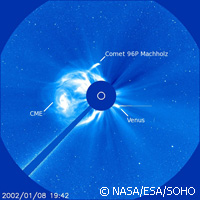SOHO spacecraft becomes greatest comet finder ever
The Solar and Heliospheric Observatory (SOHO) has become the single greatest comet finder of all time discovering its 200th comet as 2010 drew to a close. Drawing on help from amateur scientists around the world, the ESA/NASA (European Space Agency/National Aeronautics and Space Administration) spacecraft quietly reached the milestone on 26 December, 15 years after it was launched. The accolade is even more impressive as SOHO was specifically designed to monitor the Sun rather than find comets. 'Since it launched on 2 December 1995 to observe the Sun, SOHO has more than doubled the number of comets for which orbits have been determined over the last 300 years,' stated Joe Gurman, the US project scientist for SOHO at NASA's Goddard Space Flight Center in Greenbelt, Maryland. The project team acknowledged that while SOHO may take the credit, most of the hard work is done by the dozens of amateur astronomer volunteers who daily pore over the fuzzy lights dancing across the pictures produced by SOHO's LASCO (Large Angle and Spectrometric Coronagraph) cameras. According to the scientists, over 70 people from 18 different countries have helped spot comets over the last 15 years by searching through the publicly available SOHO images online. Karl Battams, who has been in charge of running the SOHO comet-sighting website since 2003 for the Naval Research Lab in Washington, US, receives reports from people who think that one of the spots in SOHO's LASCO images looks to be the correct size and brightness to be a comet and is headed for the Sun. He then confirms the finding, gives each comet an unofficial number, and then sends the information off to the Cambridge, Massachusetts, US-based Minor Planet Center, which categorises small astronomical bodies and their orbits. It took SOHO 10 years to spot its first 1,000th comets, but only 5 more to find the next 1,000. The project team explained that this boost was due partly to increased participation from comet hunters and work done to optimise the images for comet-sighting, but also due to an unexplained systematic increase in the number of comets around the Sun. Indeed, in December alone an unprecedented 37 new comets were spotted, a number high enough to qualify as a 'comet storm', according to the scientists. LASCO was not designed primarily to spot comets - its camera blocks out the brightest part of the Sun in order to better watch emissions in the Sun's much fainter outer atmosphere, or corona. Its comet-finding skills are a natural side effect as with the Sun blocked, it is also much easier to see dimmer objects such as comets. 'There is definitely a lot of science that comes with these comets,' he said. 'First, now we know there are far more comets in the inner solar system than we were previously aware of, and that can tell us a lot about where such things come from and how they're formed originally and break up,' Dr Battams explained, adding that 'we can tell that a lot of these comets all have a common origin.' Indeed, according to the astronomer, 85% of the comets discovered with LASCO are thought to come from a single group known as the Kreutz family, believed to be the remnants of a single large comet that broke up several hundred years ago.For more information, please visit: Solar and Heliospheric Observatory (SOHO) mission:http://sohowww.nascom.nasa.gov/Solar and Heliospheric Observatory (SOHO)'s comet findings:http://sungrazer.nrl.navy.mil/European Space Agency (ESA):http://www.esa.int/esaCP/index.htmlNASA:http://www.nasa.gov/mission_pages/soho/comet-2000.html
Countries
United States



